I have fallen mildly ill, as have my wife and son. So far we don’t have a positive Covid-19 test, and everyone is maximally vaccinated, but given the timing the obvious conclusions do seem likely. Wish me well, and hopefully Christmas will not be cancelled and I can keep the posts mostly going. I do have winter break to help me out.
Omicron continues to take over. Official reactions have been relatively mild, with only the Netherlands entering a lockdown that I have seen. Private reaction has been more robust, which is the best way to do it, and there are some early signs it could be having a substantial effect in the UK, although I’m guessing that is probably a mirage. As usual, we’ll know one way or another in a few days, only to have a new set of mysteries on our hands.
The big argument in the last few days was over severity. A new study on infectiousness in the UK was essentially misappropriated, and its 24 (!) hospitalized Omicron patients (0.15% of all cases, versus 0.7% of other cases, before controlling for things, then when controlling for things they mostly evened out) were cited as strong evidence that Omicron is not less severe than Delta. Whereas what the study actually said on the topic was mostly nothing, because there wasn’t enough data yet.
Thus the big row over the idea of there being ‘no evidence’ for things, and how that turns into those things being known to be wrong (or right!) at the whim of those who control the narrative, Scott Alexander writing how The Phrase ‘No Evidence’ Is a Red Flag for Bad Science Communication, and me writing up my previous harsher but fairer proposal for the Law of No Evidence that the claim that there is ‘no evidence’ for something is evidence of bullshit.
As usual, we’ll look at South Africa, the UK, Denmark and select other places, then survey other aspects, then update our probabilities.
South Africa
Here’s a news dashboard with good charts for South Africa. Looks like things may have somehow peaked there, at least in the most hard-hit areas, and that there will be far fewer ventilated patients than in previous waves.
This is one of the many ways we have more data. That doesn’t mean we’re closer to understanding it.
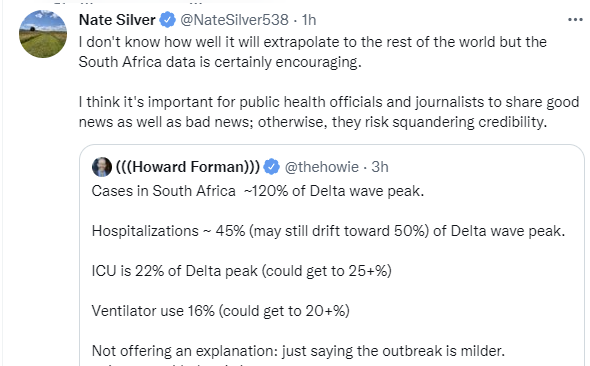
This new wave is milder per case but we already knew that. That’s not the question. Ventilator use or deaths seem better than hospitalizations since hospitalizations are partly about capacity, so 16% is encouraging, but the lag is also a thing, so the ‘could get to 20%+’ is the even more encouraging bit.
The most exciting and confusing thing is that the outbreak seems to be peaking already, at least at its point of origin in Gauteng, as usual not for any obvious reason?
Here’s an excellent interview with Trevor Bedford looking into that question. He lists five potential causes: Lack of testing, underreporting due to mildness, faster generation time, network patterns and differential vulnerability. Faster generation times are the most interesting one here. It’s worth noting that Trevor’s methods of modeling that are failing now worked for Delta in the same region, so factors that would also apply to Delta seem less plausible as explanations here.


Here’s a Twitter thread with an optimistic perspective on the South African data on severity. One note is that it’s important to properly understand what this chart means:
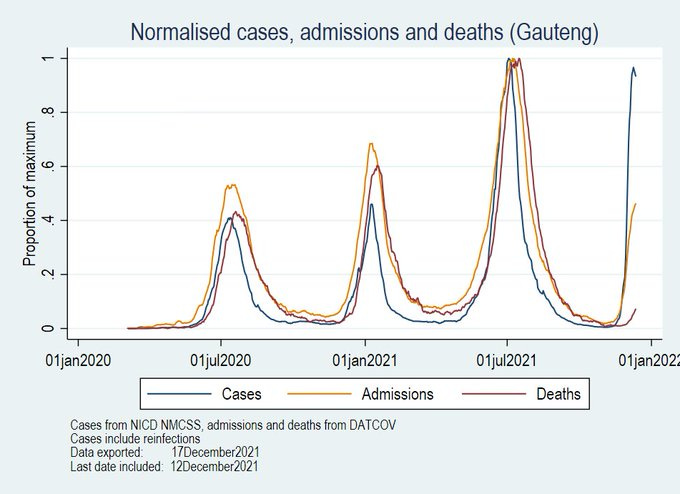
As I understand it, in South Africa they test everyone admitted to the hospital for Covid-19 and those cases will count as admissions here. So the initial thought is that this spike could be explained by that, but maybe not?
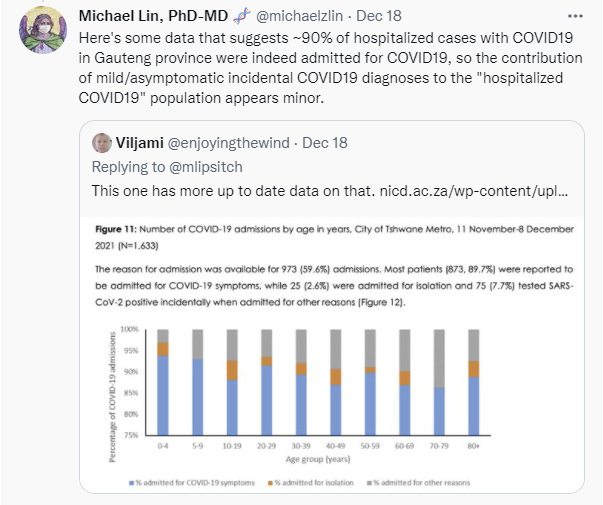
And of course there’s this, which corrects for age although not prior immunity, which does seem likely to be promising:
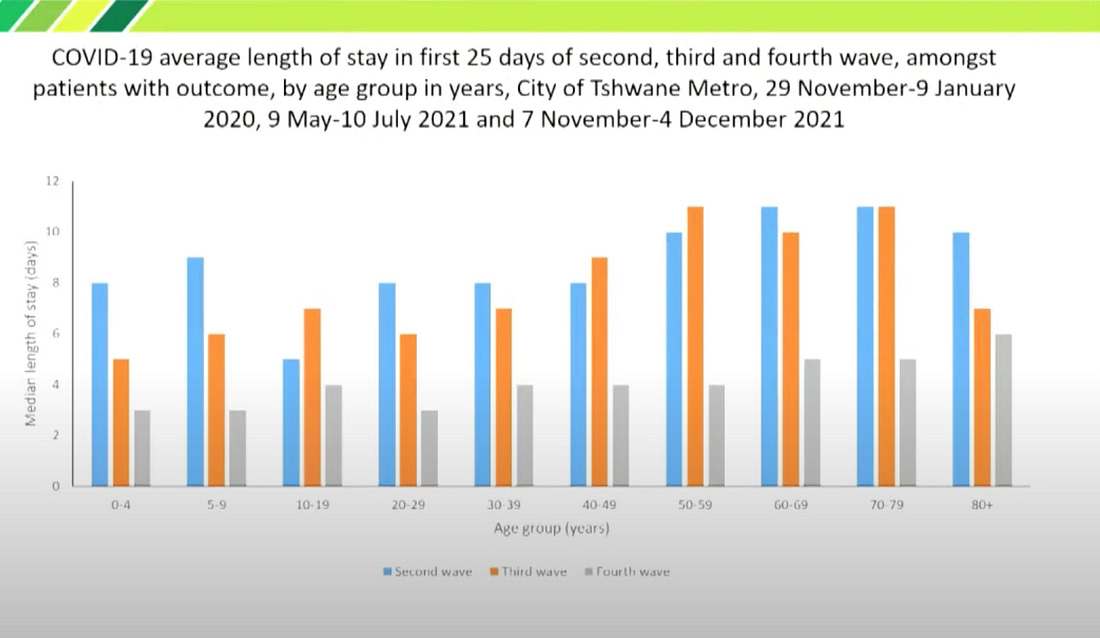
United Kingdom
The UK files daily reports, which can be found here. Makes it very clear Omicron has taken over, and that big adjustments in behavior have happened that are rapidly taking care of Delta. This link will take you to the UK technical briefings.
There are some signs of hope, perhaps, but I don’t buy it.

All this right after the big takeover:
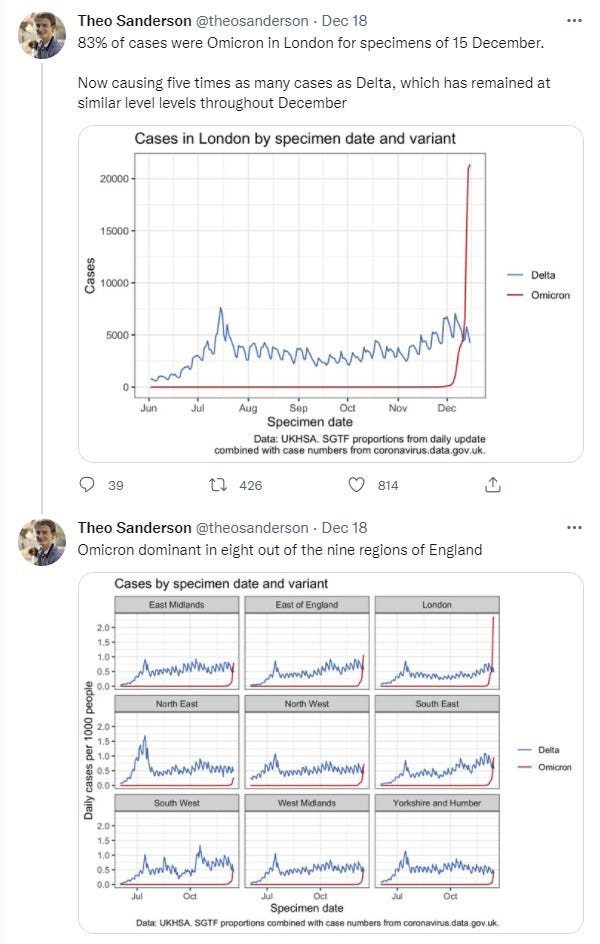
For this to be turning this fast there would need to be dramatic shifts in behavior, without implementation of a government plan. I have a ton of UK readers now, wiping out the large majority of exposures, so have we seen those kinds of shifts? To what extent?
Grant notes that we are seeing this shift across regions. That shows it isn’t random, but London’s situation is dramatically different from areas that are well behind it. So why is everything hitting a plateau at the same time? And why does Omicron’s edge over Delta seem to have shrunk so much so quickly?
This could also be the data source being quirky for some reason, as I didn’t see the same thing reflected at OurWorldInData or in any obvious way by the numbers at BNONews.
Denmark
Data on severity in Denmark initially looked rather grim, and was jumped on by all the usual suspects. New data is less grim.
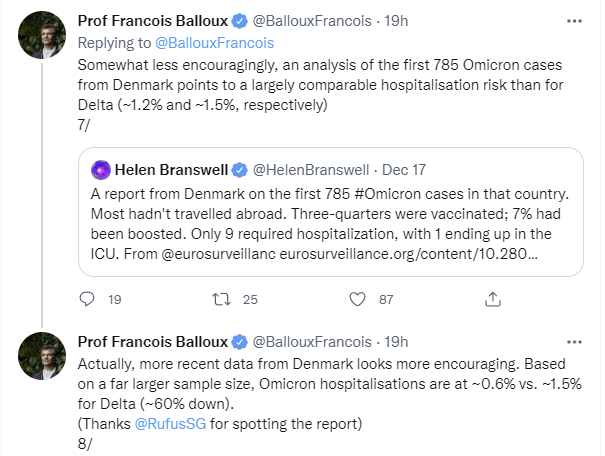
The new difference could easily disappear once we factor in reinfections and breakthroughs and age, but it’s hard to know, as opposed to the early data which would have indicated an importantly more severe strain and also would have contradicted other sources.
Copenhagen is by now mostly Omicron:
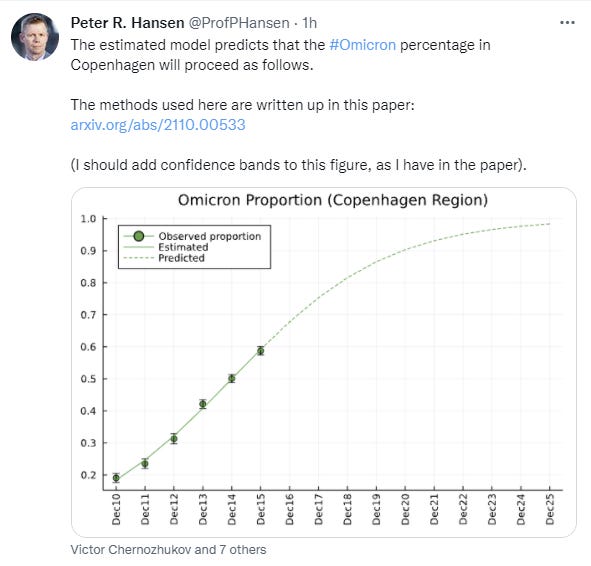

Around the World
New York Governor intends not to respond to Omicron with any shutdowns.
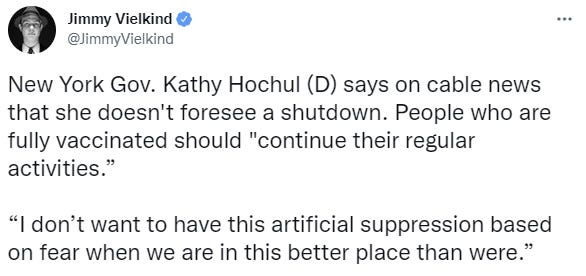
I do think such talk is meaningful but also expect it to come under extreme pressure when things get bad, if they get as bad as I expect. Meanwhile in NYC, protesters against vaccine requirements gathered at The Cheesecake Factory because people are who they are and it was a way to ensure no harm was done, and an increasing number of restaurants have been forced to temporarily shut their doors.
In Washington state, looks like Omicron has taken over.

Again it does look like a big behavioral shift is driving down Delta, even though the last few days are presumably due to data lag.
In Australia, here’s one man’s story of what happened when he tried to go to a store one day and ended up in quarantine, with lots of confused officials scrambling to figure out the situation, first telling him to quarantine at home then telling him he has to go to a medi-hotel. The story definitely has that isn’t-it-Ironic feel to it, but the important thing is that they’re still trying to contain Omicron rather than giving up. I don’t see how that’s going to work, and the numbers do not look good.
At least they’re attempting to step up their game a bit and do things that could possibly work if they get massive model uncertainty in their favor, but it does not look like they are succeeding.
The English Study
Here’s the study everyone’s talking about that didn’t find evidence of reduced severity, but did find strong evidence of much more rapid spread and frequent reinfection. Let’s dig in.
Here’s their summary.
To estimate the growth of the Omicron variant of concern (1) and its immune escape (2–9) characteristics, we analysed data from all PCR-confirmed SARS-CoV-2 cases in England excluding those with a history of recent international travel. We undertook separate analyses according to two case definitions. For the first definition, we included all cases with a definitive negative S-gene Target Failure (SGTF) result and specimen dates between 29/11/2021 and 11/12/2021 inclusive. For the second definition, we included cases with a positive genotype result and specimen date between 23/11/2021 and 11/12/2021 inclusive. We chose a later start date for the SGTF definition to ensure greater specificity of SGTF for Omicron.
We used logistic and Poisson regression to identify factors associated with testing positive for Omicron compared to non-Omicron (mostly Delta) cases. We explored the following predictors: day, region, symptomatic status, sex, ethnicity, age band and vaccination status. Our results suggest rapid growth of the frequency of the Omicron variant relative to Delta, with the exponential growth rate of its frequency estimated to be 0.34/day (95% CI: 0.33-0.35) [2.0 day doubling time] over the study period from both SGTF and genotype data. The distribution of Omicron by age, region and ethnicity currently differs markedly from Delta, with 18–29-year-olds, residents in the London region, and those of African ethnicity having significantly higher rates of infection with Omicron relative to Delta.
Hospitalisation and asymptomatic infection indicators were not significantly associated with Omicron infection, suggesting at most limited changes in severity compared with Delta.
To estimate the impact of Omicron on vaccine effectiveness (VE) for symptomatic infection we used conditional Poisson regression to estimate the hazard ratio of being an Omicron case (using SGTF definition) compared with Delta, restricting our analysis to symptomatic cases and matching by day, region, 10-year age band, sex and ethnicity. We found a significant increased risk of an Omicron case compared to Delta for those with vaccine status AZ 2+weeks post-dose 2 (PD2) , Pfizer 2+w PD2, AZ 2+w post-dose 3 (PD3) and PF 2+w PD3 vaccine states with hazard ratios of 1.86 (95%CI: 1.67-2.08), 2.68 (95%CI: 2.54-2.83), 4.32 (95%CI: 3.84-4.85) and 4.07 (95%CI: 3.66-4.51), respectively, where PD3 states are categorised by the dose 1/2 vaccine used. Depending on the Delta VE estimates used (10), these estimates translate into Omicron VE estimates of between 0% and 20% PD2 and between 55% and 80% PD3 against Omicron, consistent with other estimates (11). Similar estimates were obtained using genotype data, albeit with greater uncertainty.
To assess the impact of Omicron on reinfection rates we relied on genotype data, since SGTF is associated with a higher observed rate of reinfection, likely due to reinfections typically having higher Ct values than primary infections and therefore being subject to a higher rate of random PCR target failure. Controlling for vaccine status, age, sex, ethnicity, asymptomatic status, region and specimen date and using conditional Poisson regression to predict reinfection status, Omicron was associated with a 5.41 (95% CI: 4.87-6.00) fold higher risk of reinfection compared with Delta. This suggests relatively low remaining levels of immunity from prior infection.
The headline takeaway is a doubling time of two days or less, with a 5.41-fold higher risk of reinfection, and declining vaccine effectiveness. Severity isn’t even mentioned here.
Which makes sense, because think about the timing. The study came out on December 16. There simply has not been enough time to know which cases were and were not severe, because it’s doubling every two days so >75% of the cases in the study are going to be from the previous four days, >87% from the last six.
What do they say about severity? This seems to be it.
The distribution of Omicron by age, region and ethnicity currently differs markedly from Delta, with 18-29 year-olds, the London region, and those of African ethnicity having significantly higher rates of infection with Omicron relative to Delta. Hence the crude ratios of hospitalisations to cases shown give no information on severity on their own since risk of hospitalisation increases markedly with age. Hospitalisation and asymptomatic infection indicators were not significantly associated with Omicron infection, suggesting at most limited changes in severity compared with Delta.
…
We find no evidence (for both risk of hospitalisation attendance and symptom status) of Omicron having different severity from Delta, though data on hospitalisations are still very limited.
That all seems sensible. Without controlling for things you get a result that is meaningless. After controlling for various things as best they could, what little data we have didn’t show a difference in severity, so this is some evidence against a strong difference in severity, but data is still very limited so it’s too early to draw conclusions.
Good work, everyone. So how’s it going to get covered?
Severity and Its Discontents
A common theme of many claims about the severity of Omicron is that there is ‘no evidence’ of reduced severity. This is obvious nonsense, and a prime example of the Law of No Evidence (for which I have now written a reference post), which is:
Law of No Evidence: Any claim that there is “no evidence” of something is evidence of bullshit.
Keep an eye out for this as we examine the evidence and how it is presented.
Here’s Reuters on 17 December, talking about the English study above:

Is that what even the post thinks the study said? Let’s check the opening paragraph.
The risk of reinfection with the Omicron coronavirus variant is more than five times higher and it has shown no sign of being milder than Delta, a study showed, as cases soar across Europe and threaten year-end festivities.
It doesn’t use the words explicitly, but this is the basic ‘no evidence’ move. The study didn’t show that Omicron is milder than Delta, so the study showed that Omicron is not milder than Delta.
Except that it did not do this. It did provide some evidence against such a hypothesis, especially stronger versions of it, by not finding an effect, but the study lacked sufficient power to draw much of a conclusion even on its own terms.
Infection gives you a lot more data, and thus a lot more power to learn something, such as the much higher risk of reinfection.
“Controlling for vaccine status, age, sex, ethnicity, asymptomatic status, region and specimen date, Omicron was associated with a 5.4-fold higher risk of reinfection compared with Delta,” the study, which was dated Dec. 16, added.
The protection afforded by past infection against reinfection with Omicron may be as low as 19%
…
Depending on the estimates used for vaccine effectiveness against symptomatic infection from the Delta variant, this translates into vaccine effectiveness of between 0% and 20% after two doses, and between 55% and 80% after a booster dose.
I am going to express deep skepticism that two doses provides 20% or less protection against infection by Omicron, but I can’t rule it out.
It is very clear from the body of the article, without having to look at the paper, that the paper was designed to measure likelihood of infection, and lacks the power to know about severity.
That is not about to stop headline writers. It is also not going to stop others who should know better, and are going to do this harder. For a central example, based on that same study, apologies for the source but in context seems right to use it:
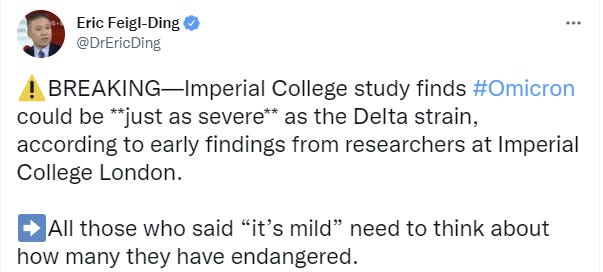
Notice the alchemy here. Study finds Omicron could be just as severe, therefore implicitly it is just as severe. The attack on those who have said otherwise as having ‘endangered’ people is used to make this leap without committing a direct logical fallacy, while also enforcing the norm that no one is allowed to make guesses that could possibly understate a somber and to be taken seriously Public Health Threat, the same way one can’t be allowed to overestimate one when it’s not yet an official threat and might Cause Panic.
This is his quoted passage and his highlighting, not mine, here’s the original FT article although you have to scroll down a bit and the link might stop working after a while:

The could be is even underlined.
Here he is later on the same thread:

So not only is it endangering people to say ‘mild,’ even if it’s milder, it would still be terrible to say that, because it wouldn’t be milder than some other third thing? Wait, why are we still discussing this?
Maybe it’s because Omicron did not evolve from Delta, which is by itself strong evidence for the prior that it’s probably milder. Why should Omicron’s baseline assumed severity be that of Delta rather than that of the strain it evolved from?
Then he says the quiet part out loud.

You’re off message, you need to stop being off message, and we’re going to cast out anyone seen being off message.
And is that off message? Because ‘mild’ implies not taking things seriously, but exponential growth means even a mild version could get really, really bad, which is totally true.
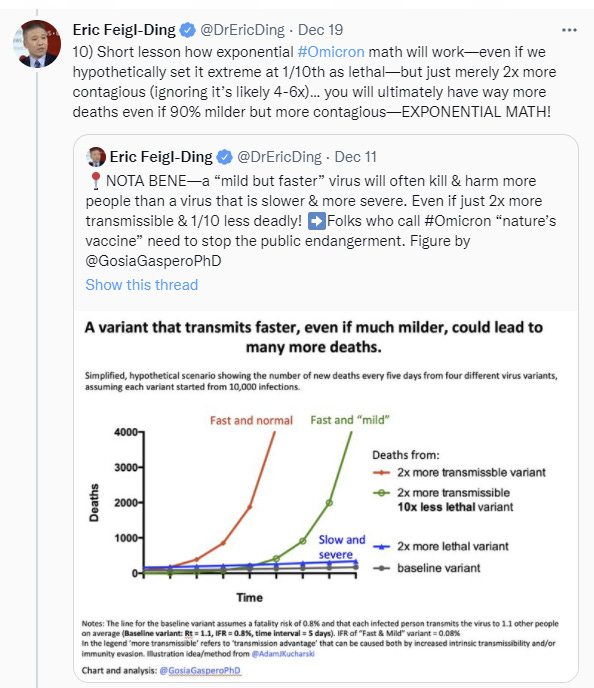
So yes. If you have ten or a hundred times as many cases, being milder only goes so far, and exponential growth still kills a lot of people. That doesn’t mean the right thing to do is start lying about the situation. Lying keeps backfiring, and we keep noticing this yet thinking it might work for us.
Nate Silver’s quote tweet response is simply (link):

Here’s another similar thread, with the same air of certainty and superiority, rubbing the failure in the face of anyone who doubted this obvious result.

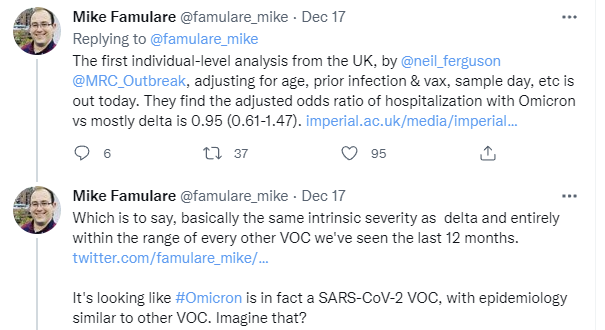

That was the default assumption by everyone, despite Omicron not having come from Delta, until we saw evidence that suggested otherwise, and that is indeed how the Bayesian prior works. We see once again this pattern of someone saying ‘how dare you have considered the possibility of milder Omicron,’ despite that of course being in the prior, and accusing people of asserting it was milder when almost everyone instead merely said it might be milder, or that we’d seen some evidence of milder.
The thread improves then, because it cites other data sources.
And then the goalpost moving, once again.
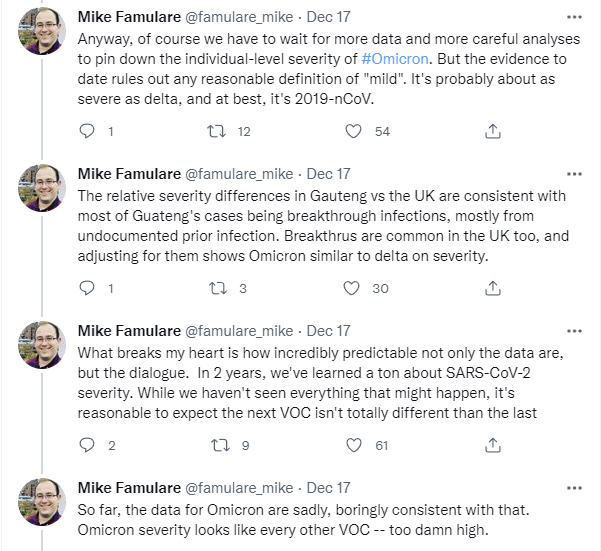
Suddenly, when the issue is the term ‘milder’ Delta and 2019-nCoV are grouped together and treated as the same. Whereas the ‘at best’ language makes it clear that they are not the same and he agrees with this. The difference is substantial and important. If Omicron is about as severe as 2019-nCoV, both that seems like it should have had a substantial amount of weight in our prior, and it’s also meaningfully good news.
It seems, once again, like such Very Serious People think that the word ‘mild’ will give the wrong idea of magnitude and/or cause behaviors they don’t like, and thus the concept must be blocked out and destroyed and those promoting it shamed.
Here’s the transformation in one easy step.

Here’s an analysis of what was actually found that seems more appropriate.
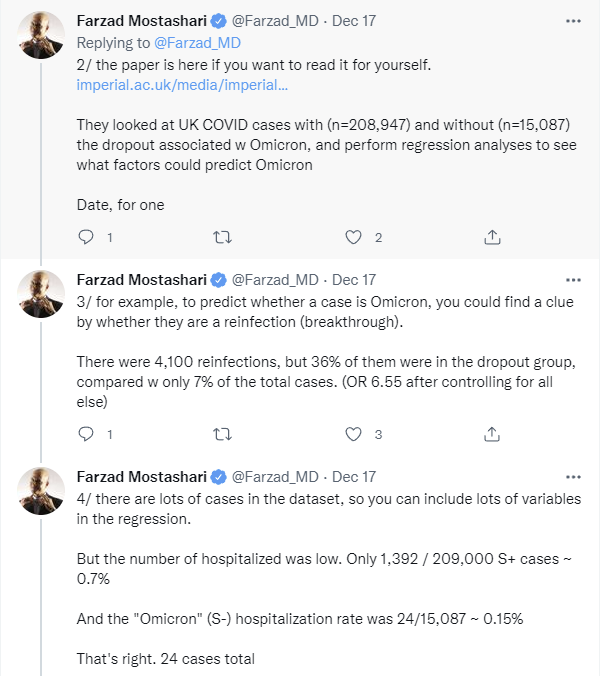


So, yes, to let you get this straight, there are only 24 hospitalizations from Omicron in this sample. That’s it. It was 0.15% of cases instead of 0.7%. After various adjustments that came out about even, which is plausible, there are a bunch of big adjustments to make, but this is nothing like big enough to rule much out that we hadn’t already ruled out. It is very little useful evidence on severity, although again it was useful evidence on spread.
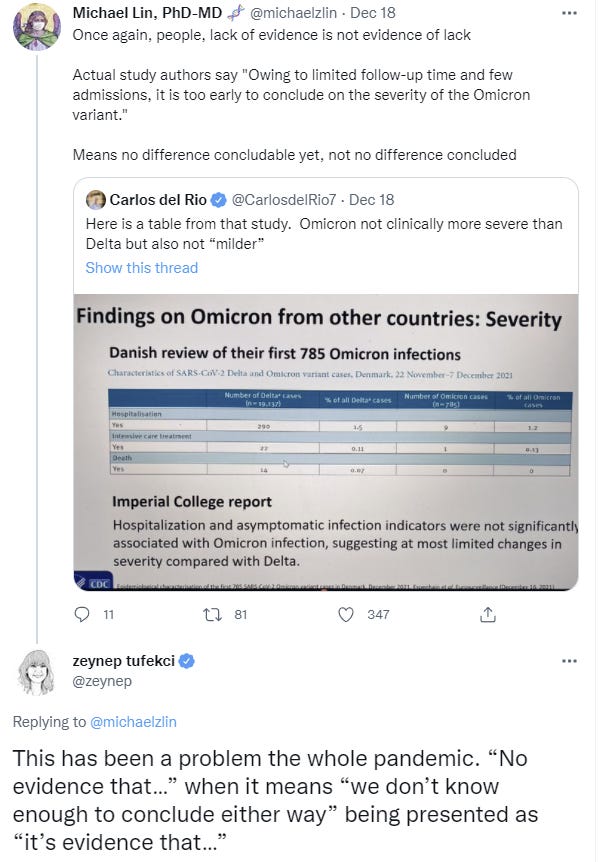
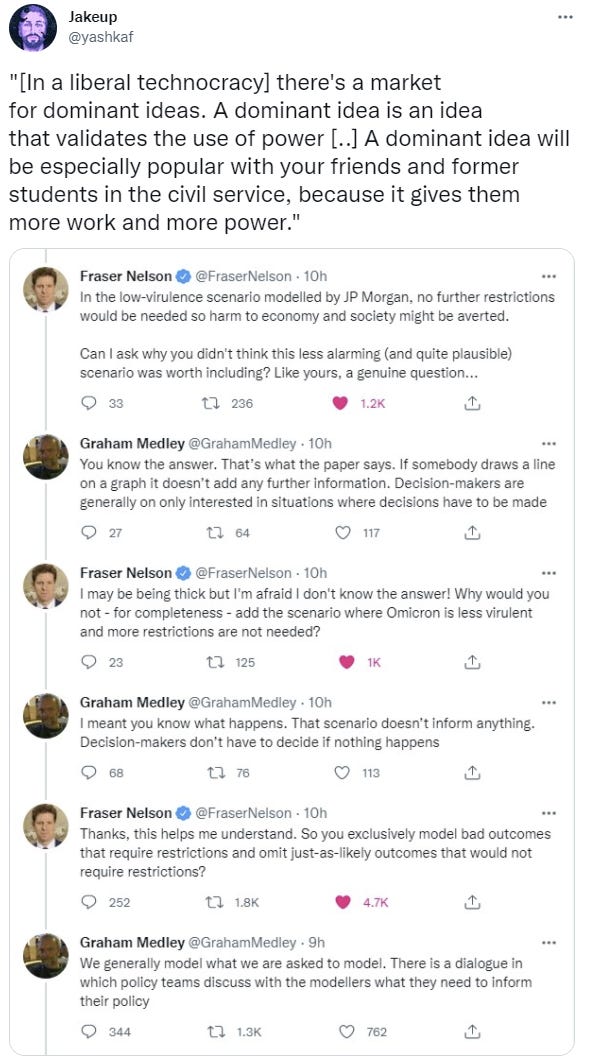
My take based on current evidence is that we can rule out dramatically milder versions, we can rule out substantially more severe versions, and the question is whether this represents something like original strain or is similar to Delta, and we still don’t have that answer.
Spread
Policy Response
The Biden Administration is scrambling to respond to Omicron.
You see, they didn’t see it coming, just like they didn’t see Delta coming.
That seems very much like a their failure to see things problem.
Seriously, Madam Vice President, if it’s this bad, have your people call me.

You can look over the track records to see exactly who did and did not ‘see this coming’ to what extent. I didn’t put that high a probability on an Omicron-like variant two months ago, this is true, but this kind of pleading is at best unbecoming.
They did finally come out with a statement, and oh boy is it a statement.
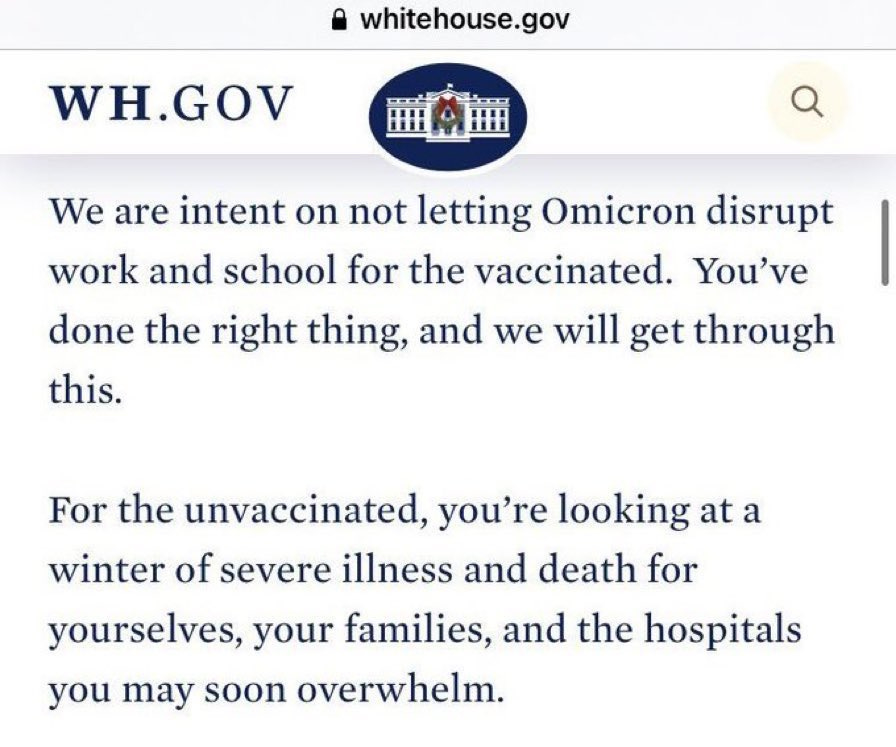
That’s a truly impressive amount of contempt and condemnation for a large percentage of the population. Good luck with that lack of disruption thing, and also at the midterms.
Other than that, their response is to ignore what is about to happen, not do anything to substantially increase testing capacity or to facilitate treatment, downplay case counts and tell people to focus on severe disease and death.
“We’re getting to the point now where … it’s about severity,” said Xavier Becerra, the secretary of the Department of Health and Human Services, in a meeting with reporters this week. “It’s not about cases. It’s about severity.”
…
“There’s a degree of difficulty that now comes in trying to decide what means it’s severe and what you have to do to stay out of that threshold of severity,” Becerra said. “But I think that’s where we’re heading, is to try to be able to tell the public that.”
They will keep the emphasis on vaccination and boosters, which like love are all you need.
“For the unvaccinated, we are looking at a winter of severe illness and death for the unvaccinated — for themselves, their families and the hospitals they’ll soon overwhelm. But there’s good news: If you’re vaccinated and you have your booster shot, you’re protected from severe illness and death,” the President said.
Always emphasize that ‘we have tools.’
“We have the tools to fight this virus, including Omicron, and we’re in a very different and stronger place than we were a year ago and there is no need to lock down,” Zients said this week.
There are two classes of tools, the Good Tools and the Bad Tools.
Vaccines, boosters, masks, social distancing and isolating when sick are The Good Tools. Those are indeed good tools.
Paxlovid, other treatments, rapid tests and any additional restrictions that people associate with ‘lockdowns’and updated boosters for Omicron are the Bad Tools, which must never be mentioned. If we mentioned them, people might be less inclined to vaccinate, so Very Serious People are acting as if they represent an infohazard. I would like to say this wouldn’t mean we’re going to actively deny people medicine, but Paxlovid remains illegal, and testing is backing up to the point of uselessness in large part because the FDA refuses to approve many tests that are in widespread use in Europe.
I continue to be happy that few are reckoning with the implications of exponential growth, despite the resulting large quantity of obvious nonsense, because the reactions I would otherwise expect would cause far more harm than good.
I continue to be highly frustrated by the refusal to take testing or treatments seriously, especially given this (in my opinion wise) decision to mostly give up on containing Omicron. There’s always time to make things somewhat better, but mostly we have already missed our window.
Meanwhile, man are these people thinking small.
Becerra said during the meeting with reporters that the administration may need to ask Congress for more funding to combat the pandemic, citing the unknowns of the new variant.
“Are we going to have more than $10 billion worth of needs and costs on Covid, especially in regards to testing?” Becerra said. “There’s a strong chance we will, depending on where Omicron takes us.”
Ten billion dollars is nothing. We had a stimulus for six trillion. It’s crazy that we’re even blinking at ten billion in real costs.
There’s also a variety of the usual two-steps-behind speculations and talk about what ‘may’ happen in January that we are reasonably confident is going to happen next week.
A reminder that the Biden administration wanted everyone boosted, and the FDA said no. The invisible graveyard is once again visible, and once again about to get larger.
Threads and Articles
Not quite this, but I had a volunteer to help as a research assistant. Too early to know if it will work out, but one of the first assignments was to chart R0 in various places using the data available, and you can check out the results here. This could be the start of something big. You never know.
NPR interview with Dr. Ashish Jha. General optimistic attitude from Jha, including flat dismissal of the possibility of lockdown, and despite skepticism from the interviewer. Doesn’t seem to grapple with the way exponential growth works, and his optimism on tests doesn’t appreciate how backed up the system already is let alone how bad it’s about to get.
Science general summary from 17 December. Optimistic on severity, points out that at sufficient scale things still get ugly. Frustratingly still refusing to admit Omicron is more infectious in addition to having escape properties, both of which seem like settled issues by now.
Trevor Bradford thread analyzing vaccine and booster effectiveness. It is looking more and more like the booster shot makes you dramatically better at fighting Omicron than the initial shots, probably because the two-shot method was never right to begin with. If you haven’t gotten your booster, strongly consider doing so, and definitely do not attempt to wait for an updated vaccine.
Trevor Bradford thread on doubling times.
Ewan Birney thread from 18 December on general state of play from UK perspective.
Kai Kupferschmidt thread from 17 December, giving an overview of what is to come. Broadly endorsed.
Christina Pagel thread from 17 December on the situation in the UK and Ireland.
Thread predicting the whole wave won’t be a big deal, as a contrasting viewpoint. Claims highly reduced severity. I am deeply skeptical but want to offer all points of view.
Reminder that displacement of Delta will not be quick, we’ll have both around at once. It is possible it will not be complete either.
Atlantic points out the obvious, which is that We Are Not Ready for Omicron.
Retrospective
Lot of the people who gave out warnings and/or were complaining about ‘vaccine equity’ are taking victory laps like this, or others are granting the laps on their behalf.
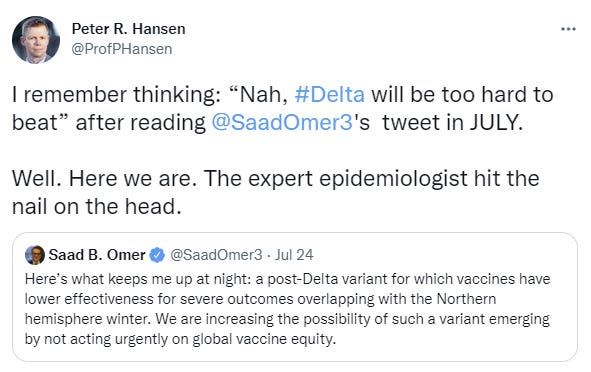
It continues to be a huge scandal that we did not scale up vaccine production faster, and that we did not distribute our surplus faster and better. In the future we must do better. That does not mean that those who effectively said ‘you should stop giving out shots or boosters because equity’ should be taking victory laps. Additional paid-for demand increases supply, and those boosters are looking more efficient per person than initial shots at this point, and the idea that we should let our lives be seriously disrupted on this basis never made sense.
There’s also the continuing question of the origins of Omicron. If Omicron had evolved from Delta, then it would be reasonable to mutter something about ‘vaccine equity’ to the extent that we could have reduced global cases farther and faster. But Omicron didn’t come from Delta, and there are major hints that it came from Covid-19 jumping into mice and then back somehow and we can combine that with its huge number of mutations and, well, you tell me what exactly we should be worried about here.
Outlook
Probability Updates and Predictions
Chance that Omicron has a 100% or bigger transmission advantage in practice versus Delta: 90% → 85%.
The various ways in which Omicron looks potentially to have been halted imply the potential for a much reduced generation time (aka serial interval) for Omicron, which would allow what we’ve witnessed without the need for a super large transmission advantage. Thus, it seems somewhat more plausible we won’t fully hit 100% after the initial wave.
Chance that Omicron is importantly more virulent than Delta: 3% → 3%.
Chance that Omicron is importantly less virulent than Delta: 60% → 50%.
I do think that the evidence this past few days was modestly in favor of similar virulence to Delta, but I did not find it conclusive or especially strong.
Will the CDC label Omicron a variant of high consequence before 2022? 11% → 9%.
This number hasn’t adjusted for the time that has passed, and it should have. Slightly rich market.
Chance we will be getting boosters modified for Omicron within 6 months of our previous booster shot: 30% → 30%.
The Europeans did order the shots, but the ‘we’ here was intended to be Americans, and it seems like we’re not interested for now. That could easily change, though.
Chance we are broadly looking at a future crisis situation with widely overwhelmed American hospitals, new large American lockdowns and things like that: 35% → 30%.
The hospitals are at capacity now, but the early promising signs (or more exactly, the lack of signs of either panic or truly horizontal lines) makes me somewhat less concerned that we’ll be unable to handle things. So I’m mildly more optimistic that we’ll ‘get away with it.’
I would like to add new probabilities to the list as better intuition pumps, but I’m not fully well at the moment, so I’m going to hold off on that at least for now.

I’ve got a legacy tournament tomorrow, what deck should I play?
If I’m trying to be thematic, miracles?
I believe this just came out, but man am I morbidly impressed by the variant proportions in the US: https://covid.cdc.gov/covid-data-tracker/#variant-proportions
Omicron already at 73%(!!!) by current estimates. Wondering what this has to say about outcompeting or displacing Delta – I think clearly it’s too early for us to have data on Omicron first -> delta immunity. Polymarket had Omicron being 50% by Jan 1st at ~83% chance before this release
I’m discussing it on Twitter, the CDC’s data don’t actually make sense. 95% in the southeast and cases didn’t double? WTF?
I don’t get this:
“If you have ten or a hundred times as many cases, being milder only goes so far, and exponential growth still kills a lot of people.”
Regardless of growth rate, being milder certainly kills fewer people. This is true unless one of two situations apply:
1. Hospitals get overwhelmed to the point of having to triage cases and choosing some to die.
2. Something happens that stops transmission for the slower scenario before it can eventually infect everyone.
I don’t think you’re talking about #1 here, I think you’re expecting that some time in the near future – before a slower transmission as from Delta could reach everyone without immunity – something else would intercede to save everyone who hasn’t been hit yet. But I can’t imagine what that agent might be.
In any case, I hope you and your family feel better quickly.
I think the language got crossed up somewhere – we’re basically on the same page.
The “vaccine equity would help fight variants” line seems highly implausible to me. Vaccination doesn’t appear to do much to prevent significant numbers of infections from cropping up (cf Gibraltar, Singapore, Portugal). So how could vaccinating the world possibly help to prevent mutations and new variants?
Feel better soon, man.
Because people who are vaccinated tend to clear the virus much faster, giving it less chance to mutate and change.
On a population scale, this adds up rapidly.
Thanks! I can’t believe I’ve never seen anyone explain that before.
The numbers have stalled in the UK probably because getting a positive PCR test now would mean you have to isolate over Christmas *by law* and no-one wants that.
With plausible contributory mechanisms for stalled counts including both (a) people not getting PCR tests when previously they would have, and (b) people taking substantial precautions to not get infected, even in the absence of formal lock-downs that would require them to.
Get will soon. Your family too :)
And thanks for the the update despite feeling under the weather.
This whole “no evidence” thing gets a bit confusing when you approvingly quote:
“We find no evidence (for both risk of hospitalisation attendance and symptom status) of Omicron having different severity from Delta, though data on hospitalisations are still very limited.”
I don’t think either you or Scott address why this use of “no evidence” is fine, in a way that will convince casual readers not already on board.
That is a fair comment and I don’t like their word use here. But I do quote it because it is their only communication on this at all, and it makes clear the study had little power. I do think it is some evidence.
The sentence as a whole makes it clear we don’t know, but that any difference isn’t big enough to be obvious after the controls applied to this sample.
The news reports make it clear that we do know.
Agreed. Context makes all the difference. In a scientific article, “no evidence for this hypothesis” is helpful information and has specific meaning different from “found evidence against this hypothesis.” I would expect the article’s target audience to understand the nuance.
In a news report, “no evidence for X” is usually a way to suggest “X is false” while maintaining plausible deniability. I would not expect a news report’s target audience to understand the nuance between those statements.
What is the point of lockind down harshly when most of the population has been vaccinated and much of them boosted? The purpose of vaccinations is to use the immunity acquired to live a normal live in contact with wild viruses. Locking down takes away that for the vaccinated & removes opportunities to acquire natural immunity for the unvaccinated, esp. when Omicron is more transmissible but milder. The main reasons for current lockdowns are I think hospital capacity (why not rehire the laid off unvaccinated staff or actually work to increase it thru less bureaucratic hurdles), cut transmissions and achieve elimination (totally Sisyphean with Omicron and further variants, and opposite to the widespread prediction that COVID will be endemic)
I suspect after this wave of lockdowns, much less will be eager to be (re)vaccinated, if lockdowns will still be imposed. Exitism will be a much more attractive option, and much of existing economy and institutions will fail Atlas Shrugged-style. On the other hand, some right-wing explanations of the whole COVID response, such as the taking away of freedoms, imposing hostile modes of living, economic destruction, etc. will gain traction, whether they are really intended or not, and civil unrest will be started over these.
This is the only possible result of not having an decent exit plan after the first lockdowns; they bet on the vaccine and they lost.
I think I should repeat this in a post about boosters: Any variant-specific boosters may be used to justify variant-specific mandates – and so we might come to a time where 80% of the population have been vaccinated for COVID at one point in their lives but only a small privileged class (caste?) have access to the all the most recently mandated vaccines and hence all social and economic functions, with the rest administratively handicapped. Hence a caste system based on something as absurd as vaccine passports. Equity problem with gradients of inequity.
The basic problem with this is the current mentality of some pro-vaxx as either over-vaccinate or be economically handicapped, with the force of law. It’s adding complexity to a problem that is unwarranted until the whole system falls apart, cliodynamics-style.
(And some anti-mandavaxxer joked that with the proliferation of variant-specific boosters, being vaccinated can become a full-time job)
Agree with that basic tradeoff between vaccination and lockdowns. (Which, based on the messaging I’m hearing, I don’t think will happen in the US, and unlike Zvi, with whom I usually agree, I’m happy about that.)
“You told me this thing works, and that’s why I have to get it. If it works, why do we still have to lock down?”
In NY there are signs up saying masks are mandatory indoors between 12/13 and 1/15, which, given the Omicron surge, I think is reasonable. My patience is going to go out the window if the cases subside by the 15th and the mask mandate is still in place.
If I gave you the impression I wanted a lockdown, I apologize. I do not.
I really think more attention should be given to geerts ideas. I fully understand my limits to understanding this complex situation. However geert ideas are so high impact if correct, they warrant adequate attention. I see this issue with investment people not fully appreciating super high risk or reward investments. https://trialsitenews.com/continued-mass-vaccination-will-only-push-the-evolutionary-capacity-of-sars-cov-2-spike-protein-beyond-the-omicron-version/. Hope you make a full recovery and refrain from going back to exercise to soon to less chances of long covid. https://www.youtube.com/watch?v=9SsTWkx6tD0
Didn’t I read some time ago that Harris said something of profound idiocy like ‘yeah, well if it was President Trump telling me to get the vaccine I probably wouldn’t get it either, ha ha ha’?
Meanwhile there is lots and lots of footage of Trump being unequivocally pro vaxx, to a much greater degree than much of his base. So why doesn’t the current govt just blitz that across the Republican airwaves and other media?
Worth remembering that there are other viruses out there, still. My whole family is currently sick with a virus that isn’t Covid or influenza, or anything else more nasal swabs than I like to think about could identify. And the local urgent care was very busy with it.
Covid was a breeze compared to this bug.
About a month ago something went around here that infected around 90% of the people I regularly interact with (mostly school aged children and their parents) and not a single one of us tested positive for Covid. Not even on a rapid test, which I suspect could be fooled by HKU1 or OC43.
We didn’t even bother going for any testing anywhere, but I personally was sick for a good 2.5 weeks.
Hmm. A non-COVID, non-flu respiratory disease, first reported at the end of a year. Why do I have a bad feeling about this?
Anecdotes: my boss and one of my coworker’s kids recently got sick with something that caused fever and coughing. All COVID tests negative. Seemingly pretty mild, thankfully.
The amazing thing bout the White House statement screenshotted above is that the policy being proposed as punishment is exactly what the vaxx-resistant want. “Oh, no, Brer Fox, please don’t let me make my own medical decisions and suffer the consequences.”
I look forward to this future in which the professional class punishes the outgroup by giving them exactly what they want.
Pingback: Tuesday assorted links - Marginal REVOLUTION
UK reader – Within the very biased sample of my london neighborhood and network, change in behaviour has been massive. (well off, well educated, liberal (in the american sense)). Every christmas party cancelled, most social engagements cancelled, pubs and restaurants have <half the customers, mask wearing back to 90% (from about 50%) when I'm in a shop. People very keen to get booster vaccine – at my local walk in center the queue was 8 hours long by 8.30am on Tuesday last. The key drivers are 1) lots of people in my area/networks have it this time (was rare in previous waves) – friends, colleagues, nursery staff of my daughter, kids at my daughter's nursery, 2) Really don't want to have to cancel xmas for elderly parents. So makes personal sense for most people to stay home, rather than being motivated by doing what's best for the public – this may unwind in the new year.
Yeah, exactly. I (41/M, 3x Moderna) would not normally limit my own activities because of a new variant, but I don’t want to have to quarantine from my parents over Christmas. So I am being very careful for a bit.
Thank you for both observation and your dedication to clear communication about the term liberal. As a “liberal American in the sense of Adam Smith and MLK”, I appreciate it!
Does anyone have good information about how omicron is doing in China? It looks like they are still keeping it down successfully, are they? With a notable cost on the economy?
“We see once again this pattern of someone saying ‘how dare you have considered the possibility of milder Omicron,’ despite that of course being in the prior”
I don’t know Mike Famulare, but the tweets shown here are largely consistent with him thinking entirely in point estimates, and verbally professing the jargon of Bayesian updating while thinking that it is a way to slide around that point estimate.
Pingback: Tuesday assorted hyperlinks - Publicinvestorday.Com
https://www.medrxiv.org/content/10.1101/2021.12.14.21267615v1 Thoughts?
Doesn’t seem consistent with other lab findings we’ve been seeing, especially 2 shots initially being better than 3 shots later, which basically doesn’t agree with anything at all.
I guess I don’t see what’s wrong with the White House statement? Isn’t I true that unvaccinated adults are more likely to suffer during this wave?
Its got a very powerful snear built into it, and explicity dissasociates (not the use of “you” and “we”) the current administration from ~40% of the polus. This is not a good thing. Putting a large swath of the country into a basket of deplorables or dismissing the 47% of the country that doesn’t pay taxes from those the president cares about is a bad thing, and this is more of that.
If, say, you think that a large number of people are refusing vaccination for culture-war and tribalism reasons, do you think that this is more likely, or less likely, to convince a marginal unvaccinated person to get vaccinated?
If, however, your job or instinct is to signal to your political tribe that they are the good ones and the other tribe is going to get the curb stomp they so richly deserve, this is the kind of statement that would make a ton of sense.
Out of curriosity, do you identify with a tribe in the US?
Yea it’s needlessly divisive. The dems seem determined to lose the next election by spreading The Opposite Of Obama’s Message.
Got it. Yeah, it would definitely have been worded in a manner to convey concern for peoples’ safety instead of almost a threat.
Pingback: Tuesday assorted hyperlinks - cryptomarket24news.com
I’ll chime in as an n-of-1 who just tested positive for covid, probably omicron given the symptoms and where I live: it’s a cold. A mild one.
Do not lock anything down for this.
Disclaimer: I’m vaccinated
Zvi thank you very much for your service with these posts. I was able last week to tell a few >50yo friends that are unboosted that they needed to get boosted Right. Now. (well, then). So your posts had the concrete benefit of allowing me to feel the sublime knife-twist of giving someone good advice and watching them ignore it.
In any case, you said last week that you haven’t reached your limit of thank yous, so thank you. I’m starting up a Frostgrave game with another family we are prepping to pod up with, and I’ve descided to pick Soothsayer as the team’s school of magic and make the head wizard “Zvi the Unheeded.”
That’s awesome. Let me know what he gets up to.
Hope you have only a mild case!
…Chance we are broadly looking at a future crisis situation with widely overwhelmed American hospitals…
Things are looking bad at my hospital. We nurses are getting fed up with management’s unconcern, and scattering to the winds. Can’t count how many have left for greener pastures, and it’s impossible to hire and train new grad replacements fast enough. I hear similar stories from nurses all over.
We are seeing plenty of at least partial lockdowns here in Europe. Denmark shut down everything where large groups gather (movie theaters, amusement parks, etc) on Dec 19. Masks and “corona passports” have been back for a few weeks now. Switzerland has a tiered shutdown that depends on your vaccine status (boosted people can do more than unboosted, who can do more than unvaccinated). Holland is partially locking down as well (Belgium is expecting an influx of locked down Dutchmen).
By the way, the Danish case numbers for the past week look especially odd, even taking account that they are preliminary. (1) Total case numbers have stopped growing, and (2) Omicron stopped increasing its share of case numbers. Both numbers are flat since the 15th. (1) can be explained by the fact that the test system is hitting it’s limits (we already do a PCR test on 4% of the population each day) and due to limiting social contact (though I don’t see much evidence of that among my social group). (2) makes very little sense. The amount of samples that have been tested for variants should make the results fairly robust at least to the 17th, but even with large errors, what are the chances that the graph would end up almost exactly flat?
https://docs.google.com/spreadsheets/d/1SrPl5MDq7csY8WJ6id5SBmMqURlAxHGvbqFH5uUHrcU/edit?usp=sharing
By the way, data comes from these two sources::
https://covid19.ssi.dk/virusvarianter/delta-pcr
https://experience.arcgis.com/experience/aa41b29149f24e20a4007a0c4e13db1d/page/page_0/
I’m getting ready for the inevitable omicron infection. Won’t persuade my family to get a booster shot in time, but at least we’re all double-vaccinated. Our cumulative hospitalization risk is ~12%, cumulative death risk is ~3.2% (16-32% if the healthcare malfunctions, and there might be a ~30% chance it will). It’s scary. :(
On my checklist: good diet, sleep, handling stress to the extent it is possible, vitamin D, vitamin C, black seed oil, zinc, quercetin, melatonin, antiseptic throat gargle, pulse oximeter (calling 112 if there are major problems and/or SpO2 is 85% or lower). Should I consider extra steps, such as getting a prescription for fluvoxamine to use at the early stages? Or anything else?
Sounds like you’re covered. Fluvoxamine is probably good if you can get it.
Should everybody, regardless of vulnerability, ask a doctor for fluvoxamine when they test positive?
There’s some limit where you’re sufficiently young I wouldn’t worry about it, but not going to claim I know where that line should be.
Is your family really old? 12%/3.2% risks sound awfully high otherwise.
Yes, relatively old, plus the oldest person has extra health issues. :(
+1 for Fluvoxamine. Also consider to get a couple of rapid tests that can be used to identify and isolate an infection early, preventing spread to the whole family.
1. How long do you expect the omicron wave to last? More like 4 or 12 weeks?
2. After that wave. should we expect a period of a negligibly small number of cases, because practically everybody got infected?
3. Would it actually make sense to intentionally get infected at the early stage (e.g. in the next two weeks), when the ventilators and a proper emergency care are still available?
4 is way too short. Although it’s fast, so perhaps? But my bet is on somewhat longer.
2. Most definitely. Chances are, it is the last wave of the pandemic.
3. Too late probably to get infected, _if_ you get into trouble, it takes a few weeks, so you’d be hitting the peak anyway. But very much depends on where exactly do you live. Timing will be different.
1. Depends what counts as the end, but I expect the peak within 3-6 weeks.
2. That requires massive overshooting, which is possible, but requires getting into many millions of cases per day.
3. My guess is it’s too late for this to make sense.
Christmas and New Years back-to-back, plus seasonal impacts, sound like a good opportunity for overshooting. These post-holiday case counts are going to be interesting.
Do you have a rough (very rough) estimate of how much less likely a random individual infected (tests positive ) with omicron today is to end up hospitalized (taking into account both a sort of expected value immunity level based on avg vaccines and prior infections per person and any possible changes in inherent virulence) compare to someone infected say March 2020?
My sense is we’re talking order of magnitude difference. Obviously the inherent virulence question is important but to the extent that we’re running out of people who are neither vaccinated nor previously infected, it strikes me as not so important (mattered way more with delta where we still had a significant percentage of population with likely no immunity.
Yeah, given it’s a random person infected, probably about a factor of ten (note: didn’t think about this for long so that’s a very rough guess).
Pingback: Tuesday assorted hyperlinks - Marginal REVOLUTION - Forbes Best
> So far we don’t have a positive Covid-19 test, and everyone is maximally vaccinated, but given the timing the obvious conclusions do seem likely.
No. It is possible a Covid test can be wrong, but it *not* likely. To suggest otherwise is misleading at best and dangerous at worst. And all parents know, pandemic or not, you get sick a lot when you have a kid. A lot. Don’t draw conclusions that are less likely and less obvious than the inevitable. There are several cold viruses circulating right now, and a lot of people are in fact getting sick from things that are not this coronavirus. We are also in a bonafide influenza season. Trust science, trust the tests for the virus, and don’t try to poke holes in things to suit your own narrative or alarmism.
I didn’t have a negative test either at the time I wrote that, but we had multiple plausible exposures at the time so I will defend that my prior was right. I do now have a negative test, which cut the chance quite a bit. But a negative rapid test isn’t super strong evidence other than for currently not being infectious. I do agree a negative PCR is strong evidence, but that’s hard to get now and I didn’t feel sufficient urgency to seek an appointment (or willingness to stand on a line with a bunch of positive people, which is the other option).
I worked out the probabilities on the FlowFlex rapid antigen test, since my spouse was exposed and needed to be tested. It turns out to have respectable Positive/Negative Predictive Values:
PPV = Pr(COVID+ | Test+) = 100%
NPV = Pr(COVID- | Test-) = 89.4%
I didn’t work out the error bars, but basically it’s quite decent.
If you tested negative, then the probability of having COVID is about 11%. Clinically, they do 2 tests in a row, 24 hours apart, to get that down even further.
Your calculations miss an a very important factor. Probabilities listed for FlowFlex(93/100) are NOT “detection of covid”, but of “matching known positive/negative samples according to pcr”. People often test negative on pcr in the beginning of covid, I personally know multiple cases, and way more anekdotes online saying the same.
@lunashields:
While it’s true the early stages can be hard to detect with any assay, that did not apply here. We were 5 days past the exposure, which is well within range for the virus to have multiplied to detectable levels.
But yeah, sure: very early detection is extremely hard.
And it’s annoying that the package insert gives things like the FDR and FNR (useful for the assay developer) but not the PPV and NPV (useful for the assay user).
I’m talking “I have obvious covid symptoms but my pcr is still negative” cases, not an extremely early detection past exposure. Again, personally know multiple cases.
My guess is because covid(at least original one) hits lungs and other internal systems a lot, so sometimes it’s present enough to give symptoms, but haven’t made it in large quantities into the nose yet. There was a reason Chinese switched to anal swab for testing at some point.
That’s fair. Our case was “no symptoms, but confirmed exposure 5 days ago”. With that much incubation time, we expected a high enough viral load to be detectable.
This is also why clinical use of rapid tests require 2 tests, 24 hours apart. It’s not just to drive down the error rate, but also to give another 24 hours of viral growth to become detectable.
It is _extremely_ likely. Every single person I know who’s had covid tested negative, usually multiple times, for the first few days of symptoms, some even with pcr’s.
Sounds like you are the one drawing premature conclusions. Zvi wrote that he didn’t have a positive test, not that he has a negative test that he chose to disbelieve.
Hypothesis: omnicrom is less virulent “overall”, virulence is not mitigated by vaccines.
If a viruses contagiousness is not impacted by vaccine and prior infection, why would severity? From what I understand the assumption that cases are breakthrough or reinfections is what drives conclusion it’s not more mild (just seeing more of these cars which would be bad except vaccines), but what if it’s mutated so much it operates more like a “regular” cold?
I have no idea if this could be right but it’s potentially an explanation and would be nice to see it studied.
Additionally – if we are at point covid variants are endemic and have shaved a year or two off life expectancy, but not more- isn’t it rational to stop measures that reduce life quality 50/75/90%. 3 years at 50% quality is like losing 1.5 years anyways.
To answer your question: if covid did not exist and life expectancy was at the currently somewhat lowered level, how many people would trade an extra year if it meant living with covid-era restrictions/etc.
My guess is very few would make that trade.
I think the English study does provide strong evidence that Omicron isn’t a lot milder (could easily be a little milder). Assuming their statement about no evidence basically means p>0.05. I wrote it up [here](https://www.reddit.com/r/dspeyer/comments/rl1lfj/the_first_halfway_decent_study_of_omicron_is_out/)
I agree, provided you’re taking everything other than the measurement at complete face value, despite it including a lot of adjustments. But again, it’s 24 cases. And I’d already felt we had enough info that it wasn’t hugely milder.
I’m still seeing people treat the hypothesis that omicron’s meaningfully milder as plausible, and even likely. And I don’t think anybody should be getting out of bed for less than a factor of two.
As for 24 cases, sometimes that’s enough. That’s why I calculated out the distributions.
>I have fallen mildly ill, as have my wife and son. So far we don’t have a positive Covid-19 test, and everyone is maximally vaccinated, but given the timing the obvious conclusions do seem likely.
Baye’s theorem! There’s probably a lot more non-covid flu than covid flu going around, especially amongst vaccinated people.
That said, congrats on winning our bet. I do notice I am very confused though, given that apparently now:
a) Omicron went suddenly to being the dominant strain in the US.
b) Daily case numbers are flat.
Logically one of (a) daily US case numbers are wrong, (b) CDCs Nowcast is wrong, or (c) for every omicron case there is one less delta case. Each option is interesting, but ultimately irrelevant for out bet given the resolution mechanism.
*Bayes’ theorem, lol.
Here’s a great Twitter thread by Deepti Gurdasani, explaining the meaning of the latest Imperial (UK) study:
OK I’m confused about this:
If the hazard ratio for Omicron is much higher post dose 3, wouldn’t that imply that dose 3 is quite a bit less effective against Omicron compared with its efficacy against delta? And 0%-20% efficacy seems shockingly low, basically inconsistent with claims that the vaccines have work against Omicron.
OK, took a look at the tables at the end of the paper, and it looks like their vaccine efficacy numbers are judged relative to v2_25+ (i.e. 25+ weeks past second dose), which is defined as 0, so the “efficacy” of remaining unvaccinated is negative. If the model is any good, which I don’t know whether I have the relevant expertise to evaluate in a reasonable amount of time, then this suggests the vaccines work (but it’s unclear how to interpret the “efficacy” number in terms of constrained anticipations), but decline in efficacy slowly over time.
Oops that was a different paper, disregard.
Against Delta, dose 3 is (at least for the first few months, we can’t be sure of long term yet) very, very effective, 95%+, and on its own it is 75%+ effective versus only 2 shots, plus extra effectiveness versus severe disease and death.
Against Omicron, I agree that 0%-20% sounds suspiciously low. My guess is that there’s some failure to control properly, perhaps the urban vs. rural divide is causing sampling issues. But it’s clearly much less effective vs. Omicron, so e.g. 30% doesn’t seem unreasonable to me. Boosting is a lot better, and the 3rd shot is the most valuable of the three. How valuable is unclear, but the lab tests say it should be pretty strong. My guess is it’s closer to 80% than 55%, but it’s sub-80 versus the old 95+. Against severe disease, hospitalization and death you’re doing better than that, but we don’t have study data on death yet.
> we can’t be sure of long term yet
Seven million people had been boosted by July, mainly in Turkey and in the Emirates, so they should probably start being able to tell — has anybody looked into that?
I don’t know of any attempt to study that population. A good study there would be useful.